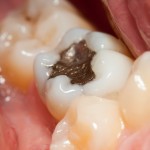
Dental amalgam has been used as a restorative material for about 150 years showing good long-term survival rates. Improvements in tooth coloured restorative materials and an increasing focus on aesthetics has seen a decline in amalgam use. Following the proposals of the Minamata Convention on Mercury amalgam use is anticipated to decline further over the coming decade. The aim of this review was to compare failure rates of amalgam and composite resin posterior restorations.
Methods
Searches were conducted in the Medline, Cochrane Central Register of Controlled Trials, and Web of Science databases. Randomised controlled trials (RCTs), controlled clinical trials and prospective and retrospective cohort studies comparing the rate of failures between occlusal and occlusoproximal amalgam and composite resin restorations with at least 12 months follow up were considered.
Two reviewers searched and screened for papers. Study quality was assessed using the Newcastle-Ottawa scale (NOS). Meta-analysis was conducted when at least two studies analysed the same data types. Binary variables (failure of restorations, secondary caries and fractures) were expressed as risk ratio (RR) with a confidence interval (CI) of 95%.
Results
- 8 studies (2 RCTs, 5 prospective and 1 retrospective cohorts) were included.
- Number of participants ranged from 27to 472, with a mean age of 21.6 years.
- Follow-up period ranged from 12 to 120 months, mean =55 months.
- 3486 occlusal and occluso-proximal cavities were restored 1844 with amalgam and 1642 composite resin.
- All studies used amalgam alloys with high copper content and dispersed phase and hybrid or microhybrid composite resins.
- The adhesive systems employed as technique were applied in two or three steps for enamel and dentine.
- Mean annual failure rate was higher for composite restorations.
- There was a statistically significant benefit in favour of amalgam for both restoration failure and secondary caries.
- There was no difference for fracture risk.
| Amalgam | Composite | |
| Mean survival (range) | 76.3 – 100% | 56 – 100% |
| Mean annual failure | 1.71% | 3.17% |
| Restoration failure (Risk ratio 95% CI) | 0.46 (95% CI: 0.28 – 0.78) | |
| Secondary caries (Risk ratio 95% CI) | 0.23 (95% CI: 018– 0.30) | |
| Fracture risk (Risk ratio 95% CI) | 1.24 (95% CI: 0.71–2.16) | |
Conclusions
The authors concluded: –
The results of this review suggest that posterior composite resin restorations still have less longevity and a greater number of secondary caries when compared to amalgam restorations. With regard to fractures, there was no statistically significant difference between the two restorative materials in relation to the time of follow-up. The data from this review should be interpreted with caution due to the inclusion of only two RCTs.
Comments
This review has screened three large databases with no language restrictions in order to identify relevant studies. Screening of the studies for inclusions was undertaken by two reviewers but it is not clear whether this, data abstraction and quality assessment has been carried out independently and in duplicate. The authors also note that only 4 studies described the technique used to insert the composite resin and control of the polymerization contraction and none reported on techniques used for the isolation of the operative field.
This review covers similar ground to the recent Cochrane review (Dental Elf – 7th Apr 2014), which included 7 RCTs that were all considered to be at high risk of bias. They also reported a significantly higher risk of restoration failure and secondary caries but no evidence of increased risk of restoration fracture. As this new review has included studies at greater risk of bias and no studies published since the Cochrane review was published, one could question the need for undertaking this piece of work.
Links
Moraschini V, Fai CK, Alto RM, Dos Santos GO. Amalgam and resin composite longevity of posterior restorations: A systematic review and meta-analysis. J Dent. 2015 Jun 24. pii: S0300-5712(15)00144-X. doi: 10.1016/j.jdent.2015.06.005. [Epub ahead of print] Review. PubMed PMID: 26116767.
Dental Elf – 15th Jun 2015 – Posterior resin restorations: high survival at 4 years
Dental Elf – 7th Apr 2014 – Amalgam still an effective filling material for posterior

Amalgam has lower failure rate in posterior restorations http://t.co/SX8sgdgi3g
Amalgam failure rate lower for posterior restorations http://t.co/SX8sgdgi3g
Las amo xD
Amalgam has lower failure rate than composite in restorations http://t.co/DDi9tEL2VA
Composite restoration had more secondary caries than amalgam http://t.co/SX8sgdgi3g
More secondary caries with composites than amalgam http://t.co/SX8sgdgi3g
Amalgam has lower failure rate than composite in restorations by The #Dental Elf. http://t.co/6Ak5uXywVV #Dentistry http://t.co/bn4n415dSx
Amalgam has lower failure rate than composite
http://t.co/tXO6rCDTlV
https://t.co/xaSzjfXPTK via @sharethis
Fewer failures in posterior teeth with amalgam restorations http://t.co/SX8sgdgi3g
Nada más!
Carolina Astete G Karen Barraza S Natalia Fuentes González http://t.co/Bqb4sOP2md
Amalgam has lower failure rate than composite in restorations https://t.co/68klSGlLx0 via @sharethis
Don’t miss – Amalgam has lower failure rate than composite restorations
http://t.co/SX8sgdgi3g
Amalgam has lower failure rate than composite in restorations https://t.co/o9oM0rCdzk via @sharethis
[…] Jul 2015 – Amalgam has lower failure rate than composite in restorations […]
not sure why RR<1 if composite has higher rates of secondary caries/restoration failure; Have the authors treated the composite group as the control group?